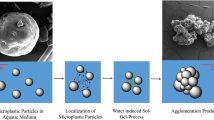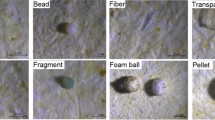Abstract
Environmental pollution caused by inert anthropogenic stressors such as microplastics in aquatic media is constantly increasing. Through the proliferating use of plastic products in daily life, more and more plastic particles enter waters as primary microplastics. Even though large scale plastic items such as plastic bottles and bags represent the highest percentage of plastic waste, their degeneration also generates microparticles and nanoparticles (secondary microplastics). Modern sewage treatment plants require innovative ideas in order to deal with this man-made problem. State-of-the-art technology offers approaches to minimise the amount of microplastics in aquatic systems. These technologies, however, are either insufficient or very costly, as well as time-consuming in both cases. The conceptual idea presented here is to apply innovative inorganic-organic hybrid silica gels which provide a cost-effective and straightforward approach. Currently, the synthesis of preorganised bioinspired compounds is advancing in order to produce functionalised hybrid silica gels in a further step. These gels have the ability to remove stressors such as microplastics from waste water. By means of the sol-gel process, bioinspired silane compounds are currently being permuted to macromolecules and examined with respect to their properties as fixation and filter material in order to remove the hydrophobic anthropogenic stressors sustainably. Here, the reproduction of biological systems plays a significant role. In particular in material sciences, this approach is becoming increasingly important. Among other concepts, new biomimetic molecules form the basis for the investigation of innovative host-guest relationships for anthropogenic stressors in the environment and their implementation in technical processes.


Similar content being viewed by others
References
Backer H, Frias M, Nicolas F, HELCOM (2014) Baltic sea sewage port reception facilities
Brannon-Peppas L, Harland RS (1990) Absorbent polymer technology. Studies in polymer science, vol 8. Elsevier; Distributors for the United States and Canada, Elsevier Science Pub, Amsterdam, New York, New York, NY, U.S.A
Browne MA, Dissanayake A, Galloway TS, Lowe DM, Thompson RC (2008) Ingested microscopic plastic translocates to the circulatory system of the mussel, Mytilus edulis (L.). Environ Sci Technol 42(13):5026–5031. doi:10.1021/es800249a
Browne MA, Crump P, Niven SJ, Teuten E, Tonkin A, Galloway T, Thompson R (2011) Accumulation of microplastic on shorelines woldwide: sources and sinks. Environ Sci Technol 45(21):9175–9179. doi:10.1021/es201811s
Claessens M, van Cauwenberghe L, Vandegehuchte MB, Janssen CR (2013) New techniques for the detection of microplastics in sediments and field collected organisms. Mar Pollut Bull 70(1–2):227–233. doi:10.1016/j.marpolbul.2013.03.009
Dekiff JH, Remy D, Klasmeier J, Fries E (2014) Occurrence and spatial distribution of microplastics in sediments from Norderney. Environ Pollut 186:248–256. doi:10.1016/j.envpol.2013.11.019
Essel R, Engel L, Carus M, Ahrens RH (2015) Quellen für Mikroplastik mit Relevanz für den Meeresschutz in Deutschland
Fries E, Dekiff JH, Willmeyer J, Nuelle M, Ebert M, Remy D (2013) Identification of polymer types and additives in marine microplastic particles using pyrolysis-GC/MS and scanning electron microscopy. Environ Sci: Processes Impacts 15(10):1949. doi:10.1039/c3em00214d
GDV, Gesamtverband der Deutschen Versicherungswirtschaft e.V. (2000) Kunststoffe
Harrison JP, Ojeda JJ, Romero-González ME (2012) The applicability of reflectance micro-Fourier-transform infrared spectroscopy for the detection of synthetic microplastics in marine sediments. Sci Total Environ 416:455–463. doi:10.1016/j.scitotenv.2011.11.078
Hartmann H, Görtz H, Grzesitza J, BASF AG (1995) Synthetische wasserlösliche Polymere-stand und ausblick. Angew Makromol Chem 123(124):1–44
Hoffmann F, Cornelius M, Morell J, Fröba M (2006) Silica-based mesoporous organic–inorganic hybrid materials. Angew Chem Int Ed 45(20):3216–3251. doi:10.1002/anie.200503075
Imhof HK, Schmid J, Niessner R, Ivleva NP, Laforsch C (2012) A novel, highly efficient method for the separation and quantification of plastic particles in sediments of aquatic environments. Limnol Oceanogr Methods 524–537
Köhler A, Moos N, Fritsch J, Löder M (2014) Aufnahme und Wirkung von Mikroplastik in Muscheln
Leslie HA, van Velzen, M. J. M., Vethaak AD (2013) Microplastic survey of the Dutch environment
Löffler MD, Morschhäuser RD (2001) Wasserlösliche Polymere und ihre Verwendung in kosmetischen und pharmazeutischen Mitteln. http://www.google.de/patents/EP1069142A1?cl=de
Mintenig S, Int-Veen I, Löder M, Gerdts G (2014) Mikroplastik in ausgewählten Kläranlagen des Oldenburgisch- Ostfriesischen Wasserverbandes (OOWV) in Niedersachsen
Moore CJ (2008) Synthetic polymers in the marine environment: a rapidly increasing, long-term threat. Environ Res 108(2):131–139. doi:10.1016/j.envres.2008.07.025
Moreau JJE, Pichon, BP, Wong Chi Man M (2005) Lamellar phenylene-bridged hybrid silicones. Composite Interfaces 11(8–9):609–616
Nuelle M, Dekiff JH, Remy D, Fries E (2014) A new analytical approach for monitoring microplastics in marine sediments. Environ Pollut 184:161–169. doi:10.1016/j.envpol.2013.07.027
Pfeifer S, Schwarzer A, Schmidt D, Brendler E, Veith M, Kroke E (2013) Precursors for pyromellit-bridged silica sol–gel hybrid materials. New J Chem 37(1):169–180. doi:10.1039/C2NJ40538E
PlasticsEurope (2015) Plastics—the facts
Schrank I, Imhof HK, Laforsch C (2014) Auswirkungen von Mikroplastik auf limnische Invertebraten. StatuskolloquiumBayerisches Landesamt für Umwelt
Schuhen, K (2015) Polykondensiertes Hybridkieselsäurematerial zur Fixierung anthropogener Verunreinigungen aus einem aquatischen Umfeld, Patent pending
Southwood TRE, Henderson PA (2000) Ecological methods, 3rd edn
Thompson RC, Olsen Y, Mitchell RP, Davis A, Rowland SJ, John A (2004) Lost at sea: where is all the plastic? Science 304(5672):838. doi:10.1126/science.1094559
Tu Y, Peng F, Adawy A, Men Y, Abdelmohsen LKEA, Wilson DA (2015) Mimicking the cell: bio-inspired functions of supramolecular assemblies. Chem Rev. doi:10.1021/acs.chemrev.5b00344
Vallé K, Belleville P, Pereira F, Sanchez C (2006) Hierarchically structured transparent hybrid membranes by in situ growth of mesostructured organosilica in host polymer. Nat Mater 5(2):107–111. doi:10.1038/nmat1570
van Cauwenberghe L, Devriese L, Galgani F, Robbens J, Janssen CR (2015) Microplastics in sediments: a review of techniques, occurrence and effects. Mar Environ Res 111:5–17. doi:10.1016/j.marenvres.2015.06.007
Velzeboer I, Kwadijk CJAF, Koelmans AA (2014) Strong sorption of PCBs to nanoplastics, microplastics, carbon nanotubes, and fullerenes. Environ Sci Technol 48(9):4869–4876. doi:10.1021/es405721v
Acknowledgments
The project is financed by the Bundesministerium für Wirtschaft und Energie (BMWi, Germany) due to a decision of the German Bundestag (Central Innovation Program for SME). The authors also acknowledge technical and research support acknowledge of the SAS Hagmann GmbH, Horb am Neckar, Germany (www.sashagmann.de) and abcr GmbH, Karlsruhe, Germany (www.abcr.de).
Author information
Authors and Affiliations
Corresponding author
Additional information
Responsible editor: Philippe Garrigues
Rights and permissions
About this article
Cite this article
Herbort, A.F., Schuhen, K. A concept for the removal of microplastics from the marine environment with innovative host-guest relationships. Environ Sci Pollut Res 24, 11061–11065 (2017). https://doi.org/10.1007/s11356-016-7216-x
Received:
Accepted:
Published:
Issue Date:
DOI: https://doi.org/10.1007/s11356-016-7216-x




